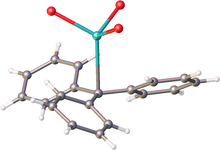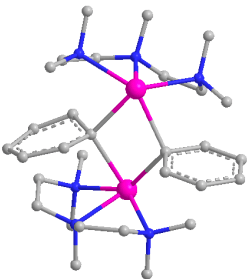Organosodium chemistry
Organosodium chemistry is the chemistry of organometallic compounds containing a carbon to sodium chemical bond.[1][2] The application of organosodium compounds in chemistry is limited in part due to competition from organolithium compounds, which are commercially available and exhibit more convenient reactivity.
The principal organosodium compound of commercial importance is sodium cyclopentadienide. Sodium tetraphenylborate can also be classified as an organosodium compound since in the solid state sodium is bound to the aryl groups.
Organometal bonds in group 1 are characterised by high polarity with corresponding high nucleophilicity on carbon. This polarity results from the disparate electronegativity of carbon (2.55) and that of lithium 0.98, sodium 0.93 potassium 0.82 rubidium 0.82 caesium 0.79). The carbanionic nature of organosodium compounds can be minimized by resonance stabilization, for example, Ph3CNa. One consequence of the highly polarized Na-C bond is that simple organosodium compounds often exist as polymers that are poorly soluble in solvents.
Synthesis
Transmetallation routes
In the original work the alkylsodium compound was accessed from the dialkylmercury compound by transmetallation. For example, diethylmercury in the Schorigin reaction or Shorygin reaction:[3][4][5]
- (C2H5)2Hg + 2 Na → 2 C2H5Na + Hg
The high solubility of lithium alkoxides in hexane is the basis of a useful synthetic route:[6]
- LiCH2SiMe3 + NaO–t–Bu → LiOt–Bu + NaCH2SiMe3
Deprotonation routes
For some acidic organic compounds, the corresponding organosodium compounds arise by deprotonation. Sodium cyclopentadienide is thus prepared by treating sodium metal and cyclopentadiene:[7]
- 2 Na + 2 C5H6 → 2 NaC5H5 + H2
Sodium acetylides form similarly. Often strong sodium bases are employed in place of the metal. Sodium methylsulfinylmethylide is prepared by treating DMSO with sodium hydride:[8]
- CH3SOCH3 + NaH → CH3SOCH−
2Na+ + H2
Metal-halogen exchange
Trityl sodium can be prepared by metal-halogen exchange. This method is used in preparing trityl sodium:[9]
- Ph3CCl + 2 Na → Ph3CNa + NaCl
Other methods
Sodium also reacts with polycyclic aromatic hydrocarbons via one-electron reduction. With solutions of naphthalene, it forms the deeply coloured radical sodium naphthalenide, which is used as a soluble reducing agent:
- C10H8 + Na → Na+[C10H8]−•
The related anthracene as well as potassium derivatives are well known.
Structures

Simple organosodium compounds such as the alkyl and aryl derivatives are generally insoluble polymers. Because of the its large radius, Na prefers a higher coordination number than does lithium in organolithium compounds. Methyl sodium adopts a polymeric structure consisting of interconnected [NaCH3]4 clusters.[11] When the organic substituents are bulky and especially in the presence of chelating ligands like TMEDA, the derivatives are more soluble. For example, [NaCH2SiMe3]TMEDA is soluble in hexane. Crystals have been shown to consist of chains of alternating Na(TMEDA)+ and CH2SiMe−
3 groups with Na–C distances ranging from 2.523(9) to 2.643(9) Å.[6]

Reactions
Organosodium compounds are traditionally used as strong bases,[9] although this application has been supplanted by other reagents such as sodium bis(trimethylsilyl)amide.
The higher alkali metals are known to metalate even some unactivated hydrocarbons and are known to self-metalate:
- 2 NaC2H5 → C2H4Na2 + C2H6
In the Wanklyn reaction (1858)[13][14] organosodium compounds react with carbon dioxide to give carboxylates:
- C2H5Na + CO2 → C2H5CO2Na
Grignard reagents undergo a similar reaction.
Some organosodium compounds degrade by beta-elimination:
- NaC2H5 → NaH + C2H4
Industrial applications
Although organosodium chemistry has been described to be of "little industrial importance", it once was central to the production of tetraethyllead.[15] A similar Wurtz coupling-like reaction is the basis of the industrial route to triphenylphosphine:
- 3 PhCl + PCl3 + 6 Na → PPh3 + 6 NaCl
The polymerization of butadiene and styrene is catalyzed by sodium metal.[3]
Organic derivatives of the heavier alkali metals
Organopotassium, organorubidium, and organocaesium are less commonly encountered than organosodium compounds and of limited utility. These compounds can be prepared by treatment of alkyl lithium compounds with the potassium, rubidium, and caesium alkoxides. Alternatively they arise from the organomercury compound, although this method is dated. The solid methyl derivatives adopt polymeric structures. Reminiscent of the nickel arsenide structure, MCH3 (M = K, Rb, Cs) has six alkali metal centers bound to each methyl group. The methyl groups are pyramidal, as expected.[11]
A notable reagent that is based on a heavier alkali metal alkyl is Schlosser's base, a mixture of n-butyllithium and potassium tert-butoxide. This reagent reacts with toluene to form the red-orange compound benzyl potassium (KCH2C6H5).
Evidence for the formation of heavy alkali metal-organic intermediates is provided by the equilibration of cis-2-butene and trans-2-butene catalysed by alkali metals. The isomerization is fast with lithium and sodium, but slow with the higher alkali metals. The higher alkali metals also favor the sterically congested conformation.[16] Several crystal structures of organopotassium compounds have been reported, establishing that they, like the sodium compounds, are polymeric.[6]
See also
References
- Synthesis of Organometallic Compounds: A Practical Guide Sanshiro Komiya Ed. 1997
- C. Elschenbroich, A. Salzer Organometallics : A Concise Introduction (2nd Ed) (1992) from Wiley-VCH: Weinheim. ISBN 3-527-28165-7
- Dietmar Seyferth "Alkyl and Aryl Derivatives of the Alkali Metals: Strong Bases and Reactive Nucleophiles. 2. Wilhelm Schlenk’s Organoalkali-Metal Chemistry. The Metal Displacement and the Transmetalation Reactions. Metalation of Weakly Acidic Hydrocarbons. Superbases" Organometallics 2009, volume 28, pp 2–33. doi:10.1021/om801047n
- P. Schorigin, "Beiträge zur Kenntnis der Kondensationen, welche durch Natrium bewirkt werden" Chem. Berichte 1907, vol. 40, 3111. doi:10.1002/cber.19070400371
- P. Schorigin, "Synthesen mittels Natrium und Halogenalkylen" Ber. 41, 2711. doi: 10.1002/cber.190804102208. P. Schorigin, "Über die Natriumalkyl-Verbindungen und über die mit ihrer Hilfe ausgeführten Synthesen" Berichte, 1908, vol. 41, 2717. doi: 10.1002/cber.190804102209. P. Schorigin, "Synthesen mittels Natrium und Halogenalkylen" Chem. Berichte, 1908, volume 41, 2711. doi: 10.1002/cber.190804102208. P. Schorigin, "Neue Synthese aromatischer Carbonsäuren aus den Kohlenwasserstoffen" Chem. Berichte 1908, vol. 41, 2723. doi:10.1002/cber.190804102210.
- William Clegg, Ben Conway, Alan R. Kennedy, Jan Klett, Robert E. Mulvey, Luca Russo "Synthesis and Structures of [(Trimethylsilyl)methyl]sodium and -potassium with Bi- and Tridentate N-Donor Ligands" Eur. J. Inorg. Chem. 2011, pp. 721–726. doi:10.1002/ejic.201000983
- Tarun K. Panda, Michael T. Gamer, and Peter W. Roesky "An Improved Synthesis of Sodium and Potassium Cyclopentadienide" Organometallics 2003, 22, 877-878. doi:10.1021/om0207865
- Iwai, I.; Ide, J. (1988). "2,3-Diphenyl-1,3-Butadiene". Organic Syntheses.CS1 maint: multiple names: authors list (link); Collective Volume, 6, p. 531
- W. B. Renfrow, Jr and C. R. Hauser (1943). "Triphenylmethylsodium". Organic Syntheses.; Collective Volume, 2, p. 607
- Vrána, Jan; Jambor, Roman; Růžička, Aleš; Dostál, Libor (2018). "New Synthetic Strategies Leading to [RNPNR]− Anions and the Isolation of the [P(Nt-Bu)3]3− Trianion". Dalton Transactions. 47 (25): 8434–8441. doi:10.1039/C8DT02141D. PMID 29897357.
- E. Weiss, "Structures of Organo Alkali Metal Complexes and Related Compounds" Angewandte Chemie International Edition in English, 1993, volume 32, pages 1501–1523. doi:10.1002/anie.199315013
- Schümann, Uwe; Behrens, Ulrich; Weiss, Erwin (April 1989). "Synthese und Struktur von Bis[μ-phenyl(pentamethyldiethylentriamin)natrium], einem Phenylnatrium-Solvat". Angewandte Chemie. 101 (4): 481–482. doi:10.1002/ange.19891010420.
- J. A. Wanklyn, Ann. 107, 125 (1858)
- The Merck index of chemicals and drugs: an encyclopedia for chemists, Paul G. Stecher
- Rolf Ackermann, Ludwig Lange "Sodium Compounds, Organic" in Ullmann's Encyclopedia of Industrial Chemistry, 2005 Wiley-VCH, Weinheim. doi:10.1002/14356007.a24_341
- Manfred Schlosser (1988). "Superbases for organic synthesis". Pure Appl. Chem. 60 (11): 1627–1634. doi:10.1351/pac198860111627.